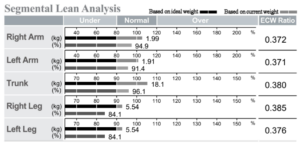Muscle soreness is something we’ve all experienced, whether you’re a fitness newbie or a seasoned athlete. It’s that unmistakable feeling after a vigorous workout or a new physical activity. But what really causes muscle soreness, and how can you benefit from understanding it better?
This article explains what muscle soreness is, what causes it, and how you can track your muscle health using body composition analyzers like those made by InBody.

What is Muscle Soreness?
Muscle soreness, often known as DOMS (delayed onset muscle soreness), is the pain and stiffness you feel in your muscles a few hours to days after doing a new or challenging exercise. It’s common to experience muscle aches within **[6 to 12 hours after a workout](https://my.clevelandclinic.org/health/symptoms/17669-muscle-pain#:~:text=When you try a new,muscles heal and get stronger.)**, and the discomfort can last up to 48 hours.
DOMS is caused by tiny muscle fibre damage during exercise, particularly when eccentric contractions are involved, such as downhill running or lengthening under load. This is a natural part of the healing and strengthening process happening within the muscles, which may cause some pain.

Muscle Soreness is Normal, But It Should Not Last Too Long
While some might wear their muscle soreness as a badge of honour, thinking it’s a sign of an effective workout, it’s essential to understand the difference between productive pain and potentially harmful pain.
Overtraining and not giving your muscles adequate time to heal can lead to injuries. Hence, understanding muscle soreness and tracking muscle health becomes vital.
Body Composition Analysis and Muscle Soreness
This is where tools like the body composition analyzer from InBody come into play. Using bioelectrical impedance analysis, InBody devices can provide detailed insights into your muscle mass, body fat percentage, and overall muscle condition.
If you experience prolonged muscle soreness, it may be helpful to check your muscle mass and related parameters in the InBody Result Sheet. A consistent or unexpected decline in muscle mass in a particular segment in the Segmental Lean Analysis, despite regular workouts, could indicate that your muscles are not recovering effectively, putting you at risk for injuries.

Additionally, if you have a higher ECW Ratio in a certain segment of your muscle, it could indicate a risk of acute inflammation due to injuries, and you may need medical help. However, it’s crucial to have your InBody results interpreted by healthcare professionals.
How Does Bioelectrical Impedance Analysis Work?
Bioelectrical impedance analysis (BIA) sends a low-level electric current through the body. Since muscles contain a large amount of water, they conduct electricity better than fat does. Thus, by measuring the resistance to this electric flow, BIA devices, like the InBody analyzer, can estimate muscle mass and body fat percentage, among other parameters.
Benefits of Tracking Muscle Health with InBody:
- Better Understanding of Recovery: If your muscle mass remains consistent or increases after exercising and experiencing muscle soreness, it indicates that your muscles are recovering well.
- Injury Prevention: If you notice a consistent decrease in muscle mass or an imbalance between muscle groups, it might be time to reconsider your workout regimen and recovery practices.
- Inflammation Indicators: Having a higher Extracellular Water (ECW) Ratio in a specific muscle group could indicate an increased risk of inflammation due to injury. Any abnormal increase in ECW Ratio levels could serve as a warning to undergo a health check before continuing with workouts.
- Tailored Workouts: By understanding your muscle health and body composition, you can design workouts that target specific muscle groups or address imbalances.

Tips to Reduce Muscle Soreness:
Here are some general tips to manage and reduce muscle soreness:
- Warm-Up and Cool-Down: Begin your workout with a proper warm-up and end it with a cool-down routine to prepare and recover your muscles.
- Stretching: Incorporate dynamic stretching before your workout and static stretching afterwards to improve flexibility and reduce muscle tension.
- Hydration: Stay well-hydrated before, during, and after exercise to prevent cramping and muscle tightness.
- Proper Nutrition: Consume a balanced diet rich in protein and antioxidants to support muscle repair and reduce inflammation.
- Gradual Progression: Avoid overexertion and gradually increase workout intensity and duration to allow your muscles to adapt.
- Rest and Recovery: Ensure adequate rest between intense workouts to give your muscles time to heal and grow.
- Active Recovery: Engage in low-intensity activities like swimming or cycling on rest days to promote blood flow and alleviate soreness.
- Massage and Foam Rolling: Use foam rollers or consider getting a massage to relieve muscle tension after your workout and improve circulation.
- Pain Management: Over-the-counter pain relievers like ibuprofen can help manage soreness, but use them sparingly and as directed.
- Listen to Your Body: If you’re in significant pain, skipping a workout or modifying your routine is okay. Pushing through severe soreness may lead to injury.
Conclusion
Muscle soreness is a common experience for many people who engage in fitness activities. It can be a sign that your muscles are working hard and growing stronger. However, it is essential to be mindful of this soreness and take steps to promote proper recovery and growth. By understanding the intricacies of muscle soreness and recovery, you can ensure that your muscles are not only growing but also thriving.
Advanced tools like InBody’s body composition analyzers can provide valuable insights into your body composition, helping you better understand the changes taking place in your muscles. Additionally, listening to your body and recognizing the signals it sends you is crucial to any fitness journey. Remember, every ache tells a story and can provide valuable information about your body’s needs. So, don’t overlook muscle soreness – use it as an opportunity to learn and grow stronger!











